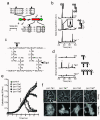Type VI secretion delivers bacteriolytic effectors to target cells
- PMID: 21776080
- PMCID: PMC3146020
- DOI: 10.1038/nature10244
Type VI secretion delivers bacteriolytic effectors to target cells
Abstract
Peptidoglycan is the major structural constituent of the bacterial cell wall, forming a meshwork outside the cytoplasmic membrane that maintains cell shape and prevents lysis. In Gram-negative bacteria, peptidoglycan is located in the periplasm, where it is protected from exogenous lytic enzymes by the outer membrane. Here we show that the type VI secretion system of Pseudomonas aeruginosa breaches this barrier to deliver two effector proteins, Tse1 and Tse3, to the periplasm of recipient cells. In this compartment, the effectors hydrolyse peptidoglycan, thereby providing a fitness advantage for P. aeruginosa cells in competition with other bacteria. To protect itself from lysis by Tse1 and Tse3, P. aeruginosa uses specific periplasmically localized immunity proteins. The requirement for these immunity proteins depends on intercellular self-intoxication through an active type VI secretion system, indicating a mechanism for export whereby effectors do not access donor cell periplasm in transit.
Figures





Comment in
-
Microbiology: Molecular syringes scratch the surface.Nature. 2011 Jul 20;475(7356):301-3. doi: 10.1038/475301a. Nature. 2011. PMID: 21776071 No abstract available.
-
Contact killing by Pseudomonas.Nat Rev Microbiol. 2011 Aug 12;9(9):632. doi: 10.1038/nrmicro2640. Nat Rev Microbiol. 2011. PMID: 21836623 No abstract available.
-
Bacterial type 6 secreted phospholipases play family feud.Cell Host Microbe. 2013 May 15;13(5):507-508. doi: 10.1016/j.chom.2013.05.002. Cell Host Microbe. 2013. PMID: 23684302 Free PMC article.
References
Online-only methods references
-
- Cardona ST, Valvano MA. An expression vector containing a rhamnose-inducible promoter provides tightly regulated gene expression in Burkholderia cenocepacia. Plasmid. 2005;54:219–228. - PubMed
-
- Horton RM, et al. Gene splicing by overlap extension. Methods in enzymology. 1993;217:270–279. - PubMed
-
- Wood PM. Periplasmic location of the terminal reductase in nitrite respiration. FEBS letters. 1978;92:214–218. doi:0014-5793(78)80757-1 [pii] - PubMed
References
-
- Hayes CS, Aoki SK, Low DA. Bacterial contact-dependent delivery systems. Annual review of genetics. 2010;44:71–90. doi:10.1146/annurev.genet.42.110807.091449. - PubMed
Publication types
MeSH terms
Substances
Grants and funding
LinkOut - more resources
Full Text Sources
Other Literature Sources
Molecular Biology Databases

